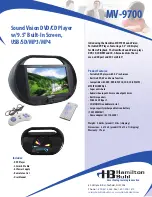
ORIGINAL INSTRUCTIONS > EN
It is advisable to always shut off the fuel supply, run the engine to fuel starvation and drain the tank when
the equipment is not in use for more than 30 days.
Connecting Liquid Petroleum Gas (LPG:
with Propane
) Cylinder
1. Make sure the fuel valve on the generator is in the off position.
2. Attach the LPG(
with Propane
) hose (included) to the LPG(
with Propane
) hose connector on the side
of the generator and tighten with a 19 mm or adjustable wrench.
Important: DO NOT
use tape or any other type of sealant to seal LPG(
with Propane
) hose connection.
3. Remove the safety plug or cap from the cylinder valve.
4. Attach the other end of the hose to the LPG(
with Propane
) connector on the cylinder and tighten.
5. Check all connections for leaks by wetting the fittings with a solution of soap and water. Bubbles which
appear or bubbles which grow indicate that a leak exists. If a leak exists at a fitting then turn off the gas
valve at the tank and tighten the fitting. Turn the gas back on and recheck the fitting with the soap and
water solution. If the leak continues or if the leak is not at a fitting then do not use the generator and contact
customer service.
NOTE
— Verify the requalification date on the tank has not expired.
— All new cylinders must be purged of air and moisture prior to filling. Used cylinders that have not been
plugged or kept closed must also be purged.
— The purging process should be done by a LPG(
with Propane
) supplier. (Cylinders from an exchange
supplier should have been purged and filled properly already).
— Always position the cylinder so the connection between the valve and the gas inlet won’t cause sharp
bends or kinks in the hose.
CAUTION:
Do not allow children to tamper or play with the cylinder or hose connections.
CAUTION:
Use approved LPG(
with Propane
) cylinders equipped with an OPD (overfilling prevention device) valve.
Always keep the cylinder in a vertical position with the valve on top and installed at ground level on a flat
surface Cylinders must not be installed near any heat source and should not be exposed to sun, rain, and
dust. When transporting and storing, turn off the cylinder valve and fuel valve, and disconnect the cylinder.
Plug the outlet, usually by a plastic protective cap, if one is available. Keep cylinders away from heat and
ventilated when in a vehicle.
WARNING:
It there is a strong smell of gas: Close off the gas supply at the cylinder. Use soapy water, which will
produce a large bubble at the point of any leak, to check the hose, and connections on the cylinder valve
and the generator. Do not smoke or light a cigarette, or check for leaks using a match, open flame source
or lighter. Contact a qualified technician to inspect and repair the LPG(
with Propane
) system if a leak is
found, before using the generator.
Grounding
Your generator must be properly connected to an appropriate ground to help prevent electric shock.
12












































